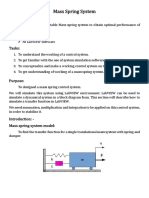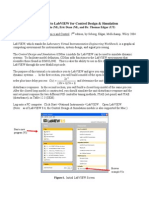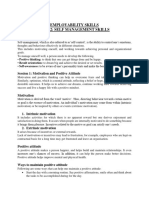LabVIEW Simulation Exercises
Uploaded by
gvkovindLabVIEW Simulation Exercises
Uploaded by
gvkovindLabVIEW Exercises
LabVIEW Simulation Exercises
Requirements: LabVIEW + LabVIEW Control Design and Simulation Module.
Exercise 1: Bacteria Population
In this example we will use LabVIEW and the LabVIEW Control Design and Simulation Module to simulate a
simple model of a bacteria population in a jar.
The model is as follows:
birth rate = bx
death rate = px2
Then the total rate of change of bacteria population is:
𝑥̇ = 𝑏𝑥 − 𝑝𝑥 3
Set b=1/hour and p=0.5 bacteria-hour
We will simulate the number of bacteria in the jar after 1 hour, assuming that initially there are 100 bacteria
present.
Procedure:
1. Draw Block Diagram using pen and paper
2. Start LabVIEW and use the Control and Simulation Loop from Control Design and Simulation Palette
in LabVIEW
3. Drag in the necessary Blocks from the palette.
4. Use the “Connection Wire” from the Tools palette and draw the necessary wires.
5. Configure Simulation Parameters (right-click on the Control and Simulation Loop border)
6. Start the Simulation
Block Diagram:
Control Design and Simulation Palette in LabVIEW:
LabVIEW Simulation Exercises
Simulation Palette in LabVIEW:
Simulation Result:
LabVIEW Simulation Exercises
Exercise 2: Mass-Spring-Damper System
In this example we will create a mass-spring-damper model in LabVIEW and configure and run the simulation in
LabVIEW.
In this exercise you will construct a simulation diagram that represents the behavior of a dynamic system. You
will simulate a spring-mass damper system.
𝐹(𝑡) − 𝑑𝑥̇ (𝑡) − 𝑘𝑥(𝑡) = 𝑚𝑥̈ (𝑡)
where t is the simulation time, F(t) is an external force applied to the system, d is the damping constant of the
spring, k is the stiffness of the spring, m is a mass, and x(t) is the position of the mass. 𝑥̇ is the first derivative of
the position, which equals the velocity of the mass. 𝑥̈ is the second derivative of the position, which equals the
acceleration of the mass.
The following figure shows this dynamic system.
The goal is to view the position x(t) of the mass m with respect to time t. You can calculate the position by
integrating the velocity of the mass. You can calculate the velocity by integrating the acceleration of the mass.
If you know the force and mass, you can calculate this acceleration by using Newton's Second Law of Motion,
given by the following equation:
Force = Mass × Acceleration
Therefore,
Acceleration = Force / Mass
Substituting terms from the differential equation above yields the following equation:
1
𝑥̈ = (𝐹 − 𝑑𝑥̇ − 𝑘𝑥)
𝑚
You should create the block diagram for the mass-spring-damper model above in LabVIEW and Simulate it
(make a plot).
Try out different values for the parameters (m, k, d, etc.) that are used the simulation.
Below you see a Block Diagram of the system (which you should implement using the blocks available in
LabVIEW):
LabVIEW Simulation Exercises
LabVIEW Simulation Exercises
You might also like
- Solutions - Control and Simulation in LabVIEWNo ratings yetSolutions - Control and Simulation in LabVIEW32 pages
- Exercise - Control and Simulation in LabVIEWNo ratings yetExercise - Control and Simulation in LabVIEW8 pages
- Control Systems Lab: Introduction To SIMULINKNo ratings yetControl Systems Lab: Introduction To SIMULINK42 pages
- Automatic Control Lab-1 Mohammed Tahhan 3392027113No ratings yetAutomatic Control Lab-1 Mohammed Tahhan 339202711316 pages
- Modeling and Digital Simulation Case Studies: 3.1 Pre-Lab AssignmentNo ratings yetModeling and Digital Simulation Case Studies: 3.1 Pre-Lab Assignment13 pages
- Modeling of Physical Systems Using Simulink.: Control System Lab 3No ratings yetModeling of Physical Systems Using Simulink.: Control System Lab 38 pages
- V' 1/m (F (T) - B V) : Creating The ModelNo ratings yetV' 1/m (F (T) - B V) : Creating The Model24 pages
- Introduction To Labview For Control Design and Simulation PDFNo ratings yetIntroduction To Labview For Control Design and Simulation PDF15 pages
- Intro To LV in 3 Hours For Control and Sim 8 - 5No ratings yetIntro To LV in 3 Hours For Control and Sim 8 - 568 pages
- Workshop - Analog Computing: Bernd Ulmann 19-APR-2006No ratings yetWorkshop - Analog Computing: Bernd Ulmann 19-APR-200640 pages
- A Quick Tutorial On LabVIEW Data AcquisitionNo ratings yetA Quick Tutorial On LabVIEW Data Acquisition12 pages
- Activity 2: Mathematical Modeling of Physical SystemsNo ratings yetActivity 2: Mathematical Modeling of Physical Systems10 pages
- Getting Started Simulation Research: CASPOCNo ratings yetGetting Started Simulation Research: CASPOC18 pages
- Laboratory 2 Hall-Effect Sensors: ME 104 Sensors and Actuators Fall 2003No ratings yetLaboratory 2 Hall-Effect Sensors: ME 104 Sensors and Actuators Fall 200313 pages
- Laboratory 2 Hall-Effect Sensors: ME 104 Sensors and Actuators Fall 2003No ratings yetLaboratory 2 Hall-Effect Sensors: ME 104 Sensors and Actuators Fall 200313 pages
- A Brief Introduction to MATLAB: Taken From the Book "MATLAB for Beginners: A Gentle Approach"From EverandA Brief Introduction to MATLAB: Taken From the Book "MATLAB for Beginners: A Gentle Approach"2.5/5 (2)
- Graphs with MATLAB (Taken from "MATLAB for Beginners: A Gentle Approach")From EverandGraphs with MATLAB (Taken from "MATLAB for Beginners: A Gentle Approach")4/5 (2)
- Modeling and LQG LTR Control For Power and Axial Power D 2014 Annals of NuclNo ratings yetModeling and LQG LTR Control For Power and Axial Power D 2014 Annals of Nucl11 pages
- Recursive Constrained State Estimation Using Modif 2014 Computers ChemicalNo ratings yetRecursive Constrained State Estimation Using Modif 2014 Computers Chemical9 pages
- Calibration of PH Meters, Glass Electrodes and Conductometers at INPLNo ratings yetCalibration of PH Meters, Glass Electrodes and Conductometers at INPL17 pages
- Networked Embedded Greenhouse Monitoring and ControlNo ratings yetNetworked Embedded Greenhouse Monitoring and Control5 pages
- Akash Karia - TED Talks Storytelling - 23 Storytelling Techniques From The Best TED Talks-CreateSpace Independent Publishing Platform (2015)No ratings yetAkash Karia - TED Talks Storytelling - 23 Storytelling Techniques From The Best TED Talks-CreateSpace Independent Publishing Platform (2015)40 pages
- Session 2 Understanding The Role of The PPST in RPMSNo ratings yetSession 2 Understanding The Role of The PPST in RPMS22 pages
- Topics To Be Covered: Binary Digital Modulation M-Ary Digital Modulation Comparison StudyNo ratings yetTopics To Be Covered: Binary Digital Modulation M-Ary Digital Modulation Comparison Study26 pages
- 365B L Your Working Advantage (AEDC0603-01)100% (1)365B L Your Working Advantage (AEDC0603-01)16 pages
- Science Form 2 March 2018 Monthly Test Marking SchemeNo ratings yetScience Form 2 March 2018 Monthly Test Marking Scheme3 pages
- Earth and Life Science SHS 3.2 Four Subsystems of EarthNo ratings yetEarth and Life Science SHS 3.2 Four Subsystems of Earth15 pages
- Microstation V8 2004 Edition: Pattern/Graphics IssueNo ratings yetMicrostation V8 2004 Edition: Pattern/Graphics Issue7 pages
- Specification FOR Saw, Plaster, Hand: Re Sffirrmd 191100% (1)Specification FOR Saw, Plaster, Hand: Re Sffirrmd 1912 pages
- Hdpe Boru Fiyat Listesi Hdpe Pipe Price ListNo ratings yetHdpe Boru Fiyat Listesi Hdpe Pipe Price List2 pages
- Potential Liquefaction of Locations Along The Pasig City Segment of The Valley Fault SystemNo ratings yetPotential Liquefaction of Locations Along The Pasig City Segment of The Valley Fault System87 pages
- Automatic Control Lab-1 Mohammed Tahhan 3392027113Automatic Control Lab-1 Mohammed Tahhan 3392027113
- Modeling and Digital Simulation Case Studies: 3.1 Pre-Lab AssignmentModeling and Digital Simulation Case Studies: 3.1 Pre-Lab Assignment
- Modeling of Physical Systems Using Simulink.: Control System Lab 3Modeling of Physical Systems Using Simulink.: Control System Lab 3
- Introduction To Labview For Control Design and Simulation PDFIntroduction To Labview For Control Design and Simulation PDF
- Workshop - Analog Computing: Bernd Ulmann 19-APR-2006Workshop - Analog Computing: Bernd Ulmann 19-APR-2006
- Activity 2: Mathematical Modeling of Physical SystemsActivity 2: Mathematical Modeling of Physical Systems
- Laboratory 2 Hall-Effect Sensors: ME 104 Sensors and Actuators Fall 2003Laboratory 2 Hall-Effect Sensors: ME 104 Sensors and Actuators Fall 2003
- Laboratory 2 Hall-Effect Sensors: ME 104 Sensors and Actuators Fall 2003Laboratory 2 Hall-Effect Sensors: ME 104 Sensors and Actuators Fall 2003
- A Brief Introduction to MATLAB: Taken From the Book "MATLAB for Beginners: A Gentle Approach"From EverandA Brief Introduction to MATLAB: Taken From the Book "MATLAB for Beginners: A Gentle Approach"
- Worked Examples in Mechanical Vibrations using MATLABFrom EverandWorked Examples in Mechanical Vibrations using MATLAB
- MATLAB for Beginners: A Gentle Approach - Revised EditionFrom EverandMATLAB for Beginners: A Gentle Approach - Revised Edition
- Top Numerical Methods With Matlab For Beginners!From EverandTop Numerical Methods With Matlab For Beginners!
- MATLAB for Beginners: A Gentle Approach - Revised EditionFrom EverandMATLAB for Beginners: A Gentle Approach - Revised Edition
- A Friendly Introduction to MATLAB ProgrammingFrom EverandA Friendly Introduction to MATLAB Programming
- Graphs with MATLAB (Taken from "MATLAB for Beginners: A Gentle Approach")From EverandGraphs with MATLAB (Taken from "MATLAB for Beginners: A Gentle Approach")
- Modeling and LQG LTR Control For Power and Axial Power D 2014 Annals of NuclModeling and LQG LTR Control For Power and Axial Power D 2014 Annals of Nucl
- Recursive Constrained State Estimation Using Modif 2014 Computers ChemicalRecursive Constrained State Estimation Using Modif 2014 Computers Chemical
- Calibration of PH Meters, Glass Electrodes and Conductometers at INPLCalibration of PH Meters, Glass Electrodes and Conductometers at INPL
- Networked Embedded Greenhouse Monitoring and ControlNetworked Embedded Greenhouse Monitoring and Control
- Akash Karia - TED Talks Storytelling - 23 Storytelling Techniques From The Best TED Talks-CreateSpace Independent Publishing Platform (2015)Akash Karia - TED Talks Storytelling - 23 Storytelling Techniques From The Best TED Talks-CreateSpace Independent Publishing Platform (2015)
- Session 2 Understanding The Role of The PPST in RPMSSession 2 Understanding The Role of The PPST in RPMS
- Topics To Be Covered: Binary Digital Modulation M-Ary Digital Modulation Comparison StudyTopics To Be Covered: Binary Digital Modulation M-Ary Digital Modulation Comparison Study
- Science Form 2 March 2018 Monthly Test Marking SchemeScience Form 2 March 2018 Monthly Test Marking Scheme
- Earth and Life Science SHS 3.2 Four Subsystems of EarthEarth and Life Science SHS 3.2 Four Subsystems of Earth
- Microstation V8 2004 Edition: Pattern/Graphics IssueMicrostation V8 2004 Edition: Pattern/Graphics Issue
- Specification FOR Saw, Plaster, Hand: Re Sffirrmd 191Specification FOR Saw, Plaster, Hand: Re Sffirrmd 191
- Potential Liquefaction of Locations Along The Pasig City Segment of The Valley Fault SystemPotential Liquefaction of Locations Along The Pasig City Segment of The Valley Fault System







































































































